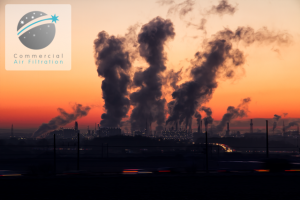Particle pollution is an important contributor to both outdoor and indoor air pollution. It is classified according to size, namely:
- PM 10 – particles of size 10 microns or less
- PM 2.5 – particles of size 2.5 microns or less
- 'Ultrafine particles' – particles of size 0.1 microns (100 nanometres) or less
These tiny particles are inhaled into the lungs and the smaller they are, the deeper they go with the smallest penetrating as far as the bloodstream. Particle pollution is responsible for a host of health impacts, from asthma attacks to premature death. Particle pollution comes from many kinds of activity, with a focus upon transport and industry. The particle pollution most of us are exposed to comes from petrol and diesel vehicles. Exhausts, particularly those from 'dirty' vehicles, emit soot particles from incomplete combustion of diesel or petrol coated with a layer of other combustion products, such as heavy metals and polyaromatic hydrocarbons (both listed as carcinogens). Then there is the friction between the tyres and the road which accounts for the emission of 25,000 tons of particle pollution dust in the USA every year). Particles by friction between brake pads and the road emit another 35,000 tons of PM pollution (figures from Hannah Holmes’ book, see below).
The formation and composition of particle pollution is complex. Research into the composition of particle pollution only really got underway in the last decade. One paper, focusing upon ultrafine particle pollution in seven cities in California, revealed the following analysis:
- Organic compounds 50%
- Trace metal oxides 14%
- Elemental carbon (soot) 8.7%
- Sulphate 8.2%
- Nitrate 6.8%
- Ammonium ion 3.7%
- Sodium 0.6%
- Chloride 0.5%
The researchers also noted that there were around 13 tonnes of ultrafine particle emissions per day in the South Coast Air Basin that surrounds Los Angeles.
Knowledge of the chemical components of particle pollution is useful for planning exposure studies in humans, because it tells us what potentially toxic substances (hydrocarbons, heavy metals) are being inhaled in particulate form. The composition picture is consistent with a chemical cocktail of pollutants being emitted in gaseous and particulate form from vehicle exhausts.
But we also need to know more about the processes that form particle pollution and their timescales. A recent paper from researchers at the University of California, Irvine, does suggest that our knowledge and understanding of this form of pollution is still evolving. They focus upon a type of particle pollution called secondary organic aerosols which are formed by interaction between the gaseous by-products of combustion and previously existing PMs. In other words, particle pollution is more persistent and more numerous than previously believed. Gaseous by-products do not just incorporate themselves into tiny airborne droplets of liquid, and float off into the atmosphere – as was previously believed. Instead, they attach themselves to particles, adsorbing on their surfaces and adding to the burden of particle pollution that we breathe in in form of regular household dust.
Sources: Holmes H. The Secret Life of Dust (Wiley, 2001) Chapter 5. A Steady Upward Rain
Cass GR et al The chemical composition of atmospheric ultrafine particles (2000) Philosophical Transactions of the Royal Society of London, Series A. 358 (1775); 2581-2592
Perraud V et al Nonequilibrium atmospheric secondary organic aerosol formation and growth (2012) Proceedings of the National Academy of Sciences 109 (8); 2836-2841




